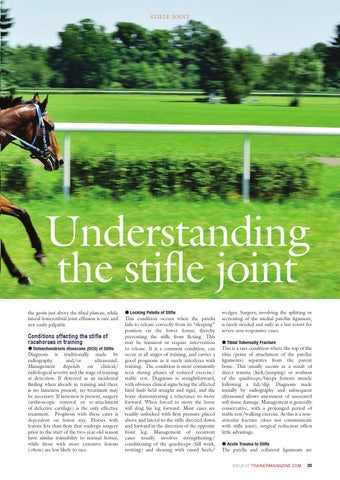STIFLE JOINT
Understanding the stifle joint the groin just above the tibial plateau, while lateral femerotibial joint effusion is rare and not easily palpable.
Conditions affecting the stifle of racehorses in training
● Osteochondrosis dissecans (OCD) of Stifle Diagnosis is traditionally made by radiography and/or ultrasound. Management depends on clinical/ radiological severity and the stage of training at detection. If detected as an incidental finding when already in training and there is no lameness present, no treatment may be necessary. If lameness is present, surgery (arthroscopic removal or re-attachment of defective cartilage) is the only effective treatment. Prognosis with these cases is dependent on lesion size. Horses with lesions less than 6cm that undergo surgery prior to the start of the two-year-old season have similar trainability to normal horses, while those with more extensive lesions (>6cm) are less likely to race.
● Locking Patella of Stifle This condition occurs when the patella fails to release correctly from its “sleeping” position on the lower femur, thereby preventing the stifle from flexing. This may be transient or require intervention to release. It is a common condition, can occur at all stages of training, and carries a good prognosis as it rarely interferes with training. The condition is most commonly seen during phases of reduced exercise/ stable rest. Diagnosis is straightforward, with obvious clinical signs being the affected hind limb held straight and rigid, and the horse demonstrating a reluctance to move forward. When forced to move the horse will drag his leg forward. Most cases are readily unlocked with firm pressure placed above and lateral to the stifle directed down and forward in the direction of the opposite front leg. Management of recurrent cases usually involves strengthening/ conditioning of the quadriceps (hill work, trotting) and shoeing with raised heels/
wedges. Surgery, involving the splitting or sectioning of the medial patellar ligament, is rarely needed and only as a last resort for severe non-responsive cases. ● Tibial Tuberosity Fracture This is a rare condition where the top of the tibia (point of attachment of the patellar ligaments) separates from the parent bone. This usually occurs as a result of direct trauma (kick/jumping) or avulsion of the quadriceps/biceps femoris muscle following a fall/slip. Diagnosis made initially by radiography and subsequent ultrasound allows assessment of associated soft tissue damage. Management is generally conservative, with a prolonged period of stable rest/walking exercise. As this is a nonarticular fracture (does not communicate with stifle joint), surgical reduction offers little advantage. ● Acute Trauma to Stifle The patella and collateral ligaments are ISSUE 51 TRAINERMAGAZINE.COM
EUROPEAN TRAINER ISSUE 51 STIFLE.indd 39
39
25/09/2015 08:13
